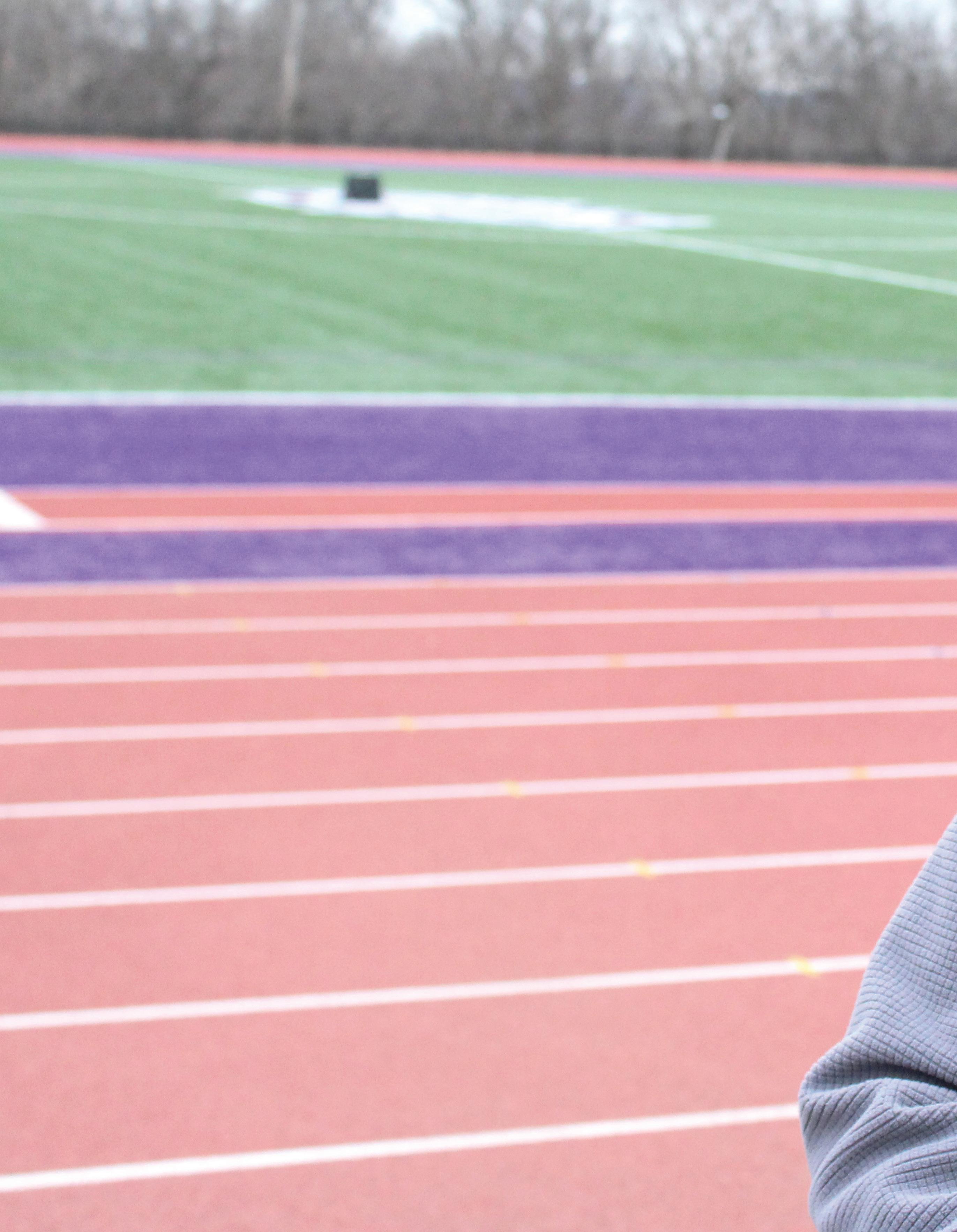
16 minute read
Exposure
from March 2017
by Le Journal
(Photo Illustration of Print Managing Editor Tara Jungden by Print Co-Editor-In-Chief Megan Ostrander)

Advertisement
...Story continued from Page 15 risk of skin cancer later in life.” occur on parts of the body that are overexposed Malignant Melanoma is the least common to the sun such as the face, neck, shoulders and form of skin cancer, but it is the deadliest, “I’m using Jergens back. BCC usually does not spread to other according to Delmont. Melanoma forms in tanning lotion for parts of the body, and is the least severe type skin cells called melanocytes and can spread spring break just to of skin cancer. Treatment varies based on the to other parts of the body. In these cells, get a nice color.” location of the cancer. However, BCC is the melanin, a brown pigment that gives the skin -sophomore Gretta most frequently occurring form of all cancers its color, is produced, leading many cases of Allen with more than 4 million cases diagnosed each visible melanoma to be dark colors like brown year, according to The Skin Cancer Foundation. or black. However, some can appear pink, tan
SCC develops in squamous cells in the or white, according to The American Cancer epidermis. Although uncommon in its early stages, SCC may spread to other areas of the body but is usually treated before any spread occurs, according to Patient. info, an online medical resource. More than 1 million cases of SCC are diagnosed each year in the United States with incidence of the disease increasing to 200 percent in the past three decades in the United States, according to The Skin Cancer Foundation. It is rare for teenagers to develop skin cancer, but it is not uncommon, according to Lindsay Delmont, a certified physician assistant working under supervision of BoardSociety. There are several treatment options for all skin cancers, depending on how aggressive the lesion is. Some cancers will require surgical excision and chemotherapy, while others may be frozen or removed by scraping and burning. “Melanoma is treated most often with surgical excision but can require radiation, chemotherapy, or other immunotherapies, medications that target the body’s immune system to fight the melanoma,” Delmont said. However, certain precautions can be 40-50 minutes How Long Do You Typically Stay Out in the Sun in the Summer?* *out of 208 student responses 1 hour or more 30-40 minutes 20-30 minutes 10-20 minutes 65.4% 3.8% 6.7% 13% 11.1% “A couple of the things we really worry about is melanoma-type lesions [on the eyes], and worsening of macular degeneration,” McGowan said. “It is rare to see many damaging effects of the sun in children and teenagers, but the majority of the UV exposure we will experience in our eyes happens before the age of 18.” The risk of developing cancerous lesions increases with age. In order to prevent eye damage and protect the eyes from cancerous lesions it is important to dilate the eyes every couple of years to check for lesions in both the front of the eye and the back, according to McGowan. “When I talk to patients about looking for UV protection, I recommend looking for sunglasses with UVA and UVB protection,” McGowan said. “People can also have a clear UV coating put on their glasses. One area that is really expanding is contact lenses that provide some amount of UV blocking.” Certified Dermatologist Dr. Mark McCune at taken in order to prevent skin cancers from Kansas City Dermatology. even forming. Look for “ABCDE” warning FAKE EXPOSURE
“Although it is rare to diagnose skin cancer signs in the chart on page 17. Don’t stay in the Harmful UV radiation can be found in in a teenager, it does occasionally happen,” sun for too long, avoid tanning and tanning not only the sun’s rays, but in tanning beds. Delmont said. “The bigger concern is that the beds and use sunscreen with a sun protection Although they are a popular way to get a actions we take as teenagers play a large role factor of at least 15 or burn-free tan, according to the Skin Cancer in the risks of skin cancer later in life. Sun more to protect the What SPF Sunscreen Do You Use?* Foundation, tanning exposure and indoor tanning bed usage as a skin. However, the best *out of 208 student responses bed’s risk factors teen and young adult will greatly increase the method for treatment is outnumber their prevention, according benefits. Indoor to Arroyo. tanning dangers can $11.99 Neutrogena Ulta Beauty SPF 30 $7.99 Coppertone Sport Target SPF 50 “When I was growing up, sunscreens weren’t highly developed and there was a general unawareness of the harmful effects of over sun-exposure,” Arroyo said. “Since my mid-30’s, I have worn sunscreen almost everyday as well as makeup with SPF 26.9% 10.6% 7.2% 1% 13.9% 40.4% 35+ 30 None 15 20 10 be easily overlooked by teenagers today. “Many kids and teenagers don’t realize the harm of not protecting their eyes from these damaging rays, and exposing yourself to the rays in a tanning bed is especially harmful,” McGowan said. protection. Definitely though, the best thing Pupil sizes decrease as we get older, and $11.79 you can do to prevent skin cancer is to avoid the risk of developing cancerous lesions that Hawaiian over-exposure to the sun and to use proper exposure from UV rays can cause increases Tropic sunscreen.” with age, according to McGowan. The UV rays Walgreens Although skin cancer is just one negative in tanning beds are associated with many future SPF 40 effect of over-exposure, there are many more health problems. Last year, the International effects to be looking out for. Heat stroke, sun Agency for Research on Cancer moved indoor $6.44 Banana Boat Sport Walmart SPF 50 poisoning, sun burns and heat rash are more examples of the sun’s negative effect on our skin and body. In addition to the skin, there are many ways the sun and UV light exposure can be damaging to our eyes, according to Pediatric Eye Care Specialist and Optometrist Jamie tanning devices to the highest cancer risk category: “carcinogenic to humans,” according to the Skin Cancer Foundation. “Indoor tanning beds significantly increase the risk of melanoma as well as nonmelanoma skin cancers, including both basal McGowan. cell carcinoma and squamous cell carcinoma,”

“I get a spray tan because it feels good to be tan and because I know [the sun] can damage my skin.” -junior Meghan Frerking
Delmont said.
Tanning at a younger age can also lead to wrinkles, age spots and premature aging. Despite all of these incredibly damaging effects of tanning beds, individuals continue to use them.
At Sun Tan City in Kansas City they remind their customers of the risks of using a tanning bed, according to manager Madi Little.
“They know the risks of UV tanning such as skin cancer, premature aging and potential skin burning,” Little said.
For those who are constantly indoor tanning, it may be because of an addiction. UV Radiation has a druglike effect, according to the Skin Cancer Foundation. People who use these beds frequently tend to feel more independent and experience symptoms of craving and withdrawal. Many people have reported that the desire to have a tanned appearance is the strongest motivation for using tanning beds, along with reported mood enhancement as well as relaxation and socialization, according to the Skin Cancer Foundation.
“I think a lot of people tan before spring break because they may be planning on going somewhere and other people there may be more tan and so they don’t want to stand out looking like a ghost,” junior Maddi Clark said. “Some people just feel more confident when they are tan.”
The obsession can especially be seen in younger ages. A recent study says that 21 percent of 14–17-year-olds who indoor tan reported difficulty quitting, and it is most difficult for those who started at 13 or younger, according to the Skin Cancer Foundation. This
“I hit the beds. I go twice a week because it makes me feel pretty.” -senior Jessica Cloughley
addiction is also related to behavioral health problems including smoking, alcohol and recreational drug use. As these studies have shown, frequent use of tanning beds can lead to unhealthy habits.
For spring break, people were headed towards the tanning beds. March through May is the peak season for tanning beds, according to Little. Most people want to get a “base tan” before they actually tan, believing that a it will help them not to burn as much.
However, according to the Centers for Disease Control and Prevention, a base tan is not a safe tan. In fact, it does little to protect the skin from damage caused by UV radiation exposure, and those who indoor tan have shown to be more likely to report being sunburnt.
Average tanning prices according to Little vary from $9 for a single visit up to $89.99 a month. Starting this July, there will be a 10 percent tax each person will have to pay every time they go in a tanning booth, according to WebMD. There are currently 15 states, including Kansas, that have banned indoor tanning for all people under the age of 18, according to the CDC. And in Missouri, for a minor, a parent’s consent is required in person.
GOOD EXPOSURE
Despite the harm sun can inflict, its rays— in moderation—are also imperative for survival
“My friends and I use the Jergens Natural Glow Lotion that’s a gradual self tanner.” -freshman Natalie Ungashick
and stable mental health.
Darkness stimulates the production of melatonin in the pineal gland. Melatonin is responsible for the drowsy and lazy feeling that leads to a state of sleepiness, according to The Guardian. This hormone is also linked closely to depression. Therefore, those who live with very little sunlight are more likely to suffer from unhappiness.
Seasonal Affective Disorder is a mild mood disorder that can occur during the winter season, when light in general is lacking and most cannot receive the proper amount of light on their eyes as well as their skin, according to psychology teacher Linda Blasdel.
“Full spectrum light hits the retinal proteins in our eyes that travels to the part of your brain called the hypothalamus before moving on to the suprachiasmatic nucleus,” Blasdel said. “That wakes us up, because the pineal gland will stop producing melatonin.”
The sun is crucial in the early years of development of the eyes, and the increase in nearsightedness appears to be due to more and more time spent indoors under artificial lights, according to The New York Times.
“Light from the sun helps stimulate those retinal proteins in the back of the eye, which sparks further development,” McGowan said.
New evidence suggests that serotonin and noradrenaline, two pleasant-feeling chemicals, are increased by the presence of light, according to The Huffington Post. Light is known to make the human body feel upbeat.
Vitamin D is another key nutrient that the body requires and its production is triggered by the ultraviolet rays in sun, according to Delmont. Vitamin D is capable of reducing strokes, heart disease, cancer and diabetes. Yet 50 percent of the population worldwide is vitamin D deficient, according to the U.S. National Library of Medicine.
The amount of vitamin D an individual needs varies based on one’s age, skin, and where they live. Drinking a glass of milk isn’t efficient to receive to the quantity needed. Another way people acquire vitamin D is from supplements as well as diet, according to Delmont. Teenagers between the ages of 14-18 need 24 milligrams a day, according to the National Institutes of Health. The body generates this vitamin D when bare skin is exposed to the sun.
“Just walking outside whenever you can and exposing your skin to the sun is beneficial. When teachers bring their classes outside in this weather that’s a really good thing,” Blasdel said. “Twenty minutes of sun exposure every day is highly recommended.”
In order to achieve overall health and happiness, time spent outside in the sun soaking in its rays is crucial. However, the exposure to too much sun is capable of having dangerous effects on various parts of our bodies, like our skin and eyes. Sunglasses and sunscreen are two of the precautions needed to be taken in order to protect your skin, prevent damage and enjoy the sun as well as its warm rays in healthy moderation.

Chart Irregular ?”// “ABCDE” “Is My Skin
Asymmetry: One side looks different than the other.
Border: These often have irregularly shaped borders.
Color: Color is often varied throughout the lesion and can have shades of brown, black, red, white or blue.
Diameter: Melanomas are typically bigger than the size of a pencil eraser but can be smaller.
Evolving: Any lesion that is changing in size, shape or color.
A New Home for Hill
Math teacher and track coach Beverly Hill finds a new home at Sion while bringing her collegiate athletic experiences to her students.
BY OLIVIA DOPHEIDE REPORTER
Students bustle through the crowded hallways of Lincoln College her spot on the team to someone else who wanted to do collegiate Preparatory Academy. Most are preoccupied with their friends sports. But now Hill picked up yet another sport: softball. According or phones and don’t notice the trophy cases lining the halls. To to Hill, softball was more fun and she wanted to have the choice of them, they’re just space fillers. But to math teacher Beverly Hill one sport now that she wasn’t on an athletic scholarship. particular trophy causes memories to flood back. Hill was a successful “We lost almost every game, but we had the time of our life,” high school track athlete who made it to State and medaled in multiple Hill said. events. “Beverly Smith” is engraved in the two-mile relay event trophy Today, Hill is combining her passion for mathematics and in that trophy case, and is a lasting memory for Hill. athletics in her current job at Sion with her position as track coach
“That’s my claim to fame,” Hill said, laughing. and math teacher. She teaches Algebra II and Honors Algebra I. It
Hill grew up in the inner city of Kansas City, Missouri and is common to see students flooding in and out of her room in the attended Border Star Elementary School, an elementary school in morning as well as after school, huddling around her board working the Kansas City Public School District. She then went on to Lincoln on math problems from a previous quiz. Her love for the girls and College Preparatory Academy and eventually had to make many tough teaching is evident in her wide smile as she answers any question decisions about her future. with ease.
“I grew up in a low-income family so I knew, I was wise enough “She is very dedicated to her job and will do anything in her to know, the only way I could get to college was to keep my grades up,” ability to help her students learn and better themselves,” junior Hill said. Caroline Mollerus said.
Her hard-working attitude eventually led her to a widely According to Thaddeous, Hill’s spirit has been rejuvenated successful athletic career in high school and college. At Lincoln Prep, since this school year. The Catholic atmosphere has played a part in Hill’s success in the two mile relay led her to excel in the 300 meter Hill’s draw to Sion. hurdles. She had more endurance than the other “She is inspired by the teachers she works hurdlers and could sprint the last straight away. Throughout her youth, Hill was involved heavily “It’s an honor with and is very impressed with the talent, dedication, and servant spirit of the Sion in both track and gymnastics, but her family’s economic situation narrowed it down to track around the time Hill started high school. to say I work at family,” Thaddeous said. Hill previously taught at a small charter school, Hogan Preparatory Academy, located “We all know that gymnastics isn’t a cheap sport,” Hill said. “So I had to take the track route.” Sion.” -math teacher Beverly Hill in Kansas City, Missouri. Sion is her first allgirls Catholic high school. “The girls are amazing. I pile everyone
Hill went to college on a track scholarship down with homework and they say thank you. at Kentucky State University, a historically I couldn’t wait to go home to my husband and black college. After transferring to the University of Kansas for her say ‘they say thank you when they leave.’ I loved that,” Hill said. sophomore year, she continued running track on a partial track “I love the respectfulness, the politeness and just the courtesy. It’s scholarship but her grueling pre-engineering major soon took awfully humbling.” precedence over her dream of running for a Division I school. Surprisingly, Hill chose to come to Sion over her alma mater
“It was hard to manage the track and the engineering. There was Lincoln Prep. According to Hill, Sion was out of her normal school a 4.0 pre-engineering student who was a pole vaulter and I was so stereotype. Previously teaching in an urban setting, she wanted a jealous of him,” Hill said. “The transferring didn’t help me. If I started change. That change being represented in a Catholic school, Hill there maybe it would’ve made a difference.” wanted to be able to pray in the workplace. She feels that her career
Hill did meet her husband, Thaddeous Hill, at KU but still path has gone in exactly the right direction. decided it wasn’t the place for her athletically, academically or socially. “It’s an honor to say I work at Sion,” Hill said.
“KU is so big, but I never felt so lonely,” Hill said. “I was one of As a new addition to the track coaching staff, Hill plans to about 30,000 students and I was so lonely.” bring her experience in college to the team and instill lessons that
At KU, she ran mostly indoor track before transferring back to she’s learned. One of her mottos she tries to teach her runners is “if Kentucky State University. According to Hill, she never found girls you don’t stand for anything you’ll fall for everything.” at KU like the ones she had on her high school relay team. Without a Students continue to bustle through the hallways, except this close-knit team, Hill had trouble fully enjoying the sport. Her athletic time they are in grey kilts and polos. For Hill, these hallways career took a turn during this transition. represent new opportunities to teach the girls of Sion what she
Returning to KSU, Hill received a full ride academic scholarship, has learned from her past 15 years of teaching and personal which meant she wasn’t required to run track anymore, due to her experiences 3.7 GPA her freshman year. Hill lost her passion for track and passed “Sion is a breath of fresh air for me,” Hill said.



